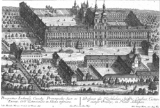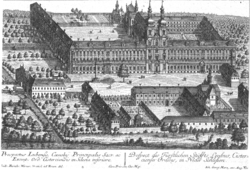
Lubiaz
Encyclopedia
Lubiąż ' is a village on the east bank of the Odra (Oder) River, in the administrative district of Gmina Wołów, within Wołów County, Lower Silesian Voivodeship
, in south-western Poland. It lies approximately 14 kilometres (9 mi) south-west of Wołów, and 42 kilometres (26 mi) west of the regional capital Wrocław. The village has a population of 2,300.
The village is mainly known for its large abbey. The Abbey was built by the Benedictine
s in 1150, and occupied by Cistercians in 1163 until 1810. Built over centuries, the abbey – the largest Cistercian abbey in the world – is rated in the highest class ("0") of landmarks of world's cultural heritage.
Lubiąż is also known in Poland
for its regional psychiatric hospital.
 The village is located on one of the oldest river crossings in Silesia. This crossing was protected by a castle, which was probably destroyed in 1108, and populated by Poles, who lived in a market named Lubies, which was documented in 1175. From the 11th century the settlement belonged to various Silesia
The village is located on one of the oldest river crossings in Silesia. This crossing was protected by a castle, which was probably destroyed in 1108, and populated by Poles, who lived in a market named Lubies, which was documented in 1175. From the 11th century the settlement belonged to various Silesia
n principalities ruled by dukes of the Silesian branch
of the Piast dynasty.
 In the middle of the 12th century an abbey was founded on the place of the former castle. Sources disagree on the exact date and nature of the foundation. While some sources claim the monastery was founded around 1150 by Benedictines and soon after passed to the Cistercians, other sources argue the monastery was founded by Cistercians around 1163. The deed of foundation was ratified in 1175 by Bolesław I the Tall, who chose the abbey as the burial place for him and his dynasty. The monastery was settled with Cistercian monks from Pforta
In the middle of the 12th century an abbey was founded on the place of the former castle. Sources disagree on the exact date and nature of the foundation. While some sources claim the monastery was founded around 1150 by Benedictines and soon after passed to the Cistercians, other sources argue the monastery was founded by Cistercians around 1163. The deed of foundation was ratified in 1175 by Bolesław I the Tall, who chose the abbey as the burial place for him and his dynasty. The monastery was settled with Cistercian monks from Pforta
in the Margraviate of Meissen, Bolesław refuge during his stay in Germany. In the same document the duke allowed the monastery to settle their territory with Germans and to exclude them from Polish law, making it the first place of the Ostsiedlung
in Silesia. The German "Städtel" (small town) Leubus was founded on the place of the former Polish market, the place Germanized, and received German town law in 1249.
The region passed to the Crown of Bohemia in 1329 and thus became part of the Holy Roman Empire
. On 30 June 1432 the Hussites invaded the village, devastating and burning the monastery. The area was heavily affected by the Thirty Years' War
. In 1632 it was plundered by the Saxons
, and in 1639 was occupied by Swedish
forces. In 1740 Silesia (and so Leubus) was taken from Austria
by the Kingdom of Prussia
. Municipal law was lost in 1740, and irrevocably in 1844. From 1871 until 1945 Leubus belonged to unified Germany
. It then passed to Poland along with the bulk of Silesia (see Territorial changes of Poland after World War II
). The German inhabitants were expelled, the village resettled by Poles and renamed to Lubiąż.
Lower Silesian Voivodeship
Lower Silesian Voivodeship, or Lower Silesia Province , is one of the 16 voivodeships into which Poland is currently divided. It lies in southwestern Poland...
, in south-western Poland. It lies approximately 14 kilometres (9 mi) south-west of Wołów, and 42 kilometres (26 mi) west of the regional capital Wrocław. The village has a population of 2,300.
The village is mainly known for its large abbey. The Abbey was built by the Benedictine
Benedictine
Benedictine refers to the spirituality and consecrated life in accordance with the Rule of St Benedict, written by Benedict of Nursia in the sixth century for the cenobitic communities he founded in central Italy. The most notable of these is Monte Cassino, the first monastery founded by Benedict...
s in 1150, and occupied by Cistercians in 1163 until 1810. Built over centuries, the abbey – the largest Cistercian abbey in the world – is rated in the highest class ("0") of landmarks of world's cultural heritage.
Lubiąż is also known in Poland
Poland
Poland , officially the Republic of Poland , is a country in Central Europe bordered by Germany to the west; the Czech Republic and Slovakia to the south; Ukraine, Belarus and Lithuania to the east; and the Baltic Sea and Kaliningrad Oblast, a Russian exclave, to the north...
for its regional psychiatric hospital.
History

Silesia
Silesia is a historical region of Central Europe located mostly in Poland, with smaller parts also in the Czech Republic, and Germany.Silesia is rich in mineral and natural resources, and includes several important industrial areas. Silesia's largest city and historical capital is Wrocław...
n principalities ruled by dukes of the Silesian branch
Silesian Piasts
The Silesian Piasts were the oldest line of the Piast dynasty beginning with Władysław II the Exile, son of Bolesław III Wrymouth, Duke of Poland...
of the Piast dynasty.

Pforta
Pforta, or Schulpforta, is a former Cistercian monastery, Pforta Abbey , near Naumburg on the Saale River in the German state of Saxony-Anhalt. It is now a celebrated German public boarding school, called Landesschule Pforta...
in the Margraviate of Meissen, Bolesław refuge during his stay in Germany. In the same document the duke allowed the monastery to settle their territory with Germans and to exclude them from Polish law, making it the first place of the Ostsiedlung
Ostsiedlung
Ostsiedlung , also called German eastward expansion, was the medieval eastward migration and settlement of Germans from modern day western and central Germany into less-populated regions and countries of eastern Central Europe and Eastern Europe. The affected area roughly stretched from Slovenia...
in Silesia. The German "Städtel" (small town) Leubus was founded on the place of the former Polish market, the place Germanized, and received German town law in 1249.
The region passed to the Crown of Bohemia in 1329 and thus became part of the Holy Roman Empire
Holy Roman Empire
The Holy Roman Empire was a realm that existed from 962 to 1806 in Central Europe.It was ruled by the Holy Roman Emperor. Its character changed during the Middle Ages and the Early Modern period, when the power of the emperor gradually weakened in favour of the princes...
. On 30 June 1432 the Hussites invaded the village, devastating and burning the monastery. The area was heavily affected by the Thirty Years' War
Thirty Years' War
The Thirty Years' War was fought primarily in what is now Germany, and at various points involved most countries in Europe. It was one of the most destructive conflicts in European history....
. In 1632 it was plundered by the Saxons
Saxony
The Free State of Saxony is a landlocked state of Germany, contingent with Brandenburg, Saxony Anhalt, Thuringia, Bavaria, the Czech Republic and Poland. It is the tenth-largest German state in area, with of Germany's sixteen states....
, and in 1639 was occupied by Swedish
Sweden
Sweden , officially the Kingdom of Sweden , is a Nordic country on the Scandinavian Peninsula in Northern Europe. Sweden borders with Norway and Finland and is connected to Denmark by a bridge-tunnel across the Öresund....
forces. In 1740 Silesia (and so Leubus) was taken from Austria
Austria
Austria , officially the Republic of Austria , is a landlocked country of roughly 8.4 million people in Central Europe. It is bordered by the Czech Republic and Germany to the north, Slovakia and Hungary to the east, Slovenia and Italy to the south, and Switzerland and Liechtenstein to the...
by the Kingdom of Prussia
Prussia
Prussia was a German kingdom and historic state originating out of the Duchy of Prussia and the Margraviate of Brandenburg. For centuries, the House of Hohenzollern ruled Prussia, successfully expanding its size by way of an unusually well-organized and effective army. Prussia shaped the history...
. Municipal law was lost in 1740, and irrevocably in 1844. From 1871 until 1945 Leubus belonged to unified Germany
Germany
Germany , officially the Federal Republic of Germany , is a federal parliamentary republic in Europe. The country consists of 16 states while the capital and largest city is Berlin. Germany covers an area of 357,021 km2 and has a largely temperate seasonal climate...
. It then passed to Poland along with the bulk of Silesia (see Territorial changes of Poland after World War II
Territorial changes of Poland after World War II
The territorial changes of Poland after World War II were very extensive. In 1945, following the Second World War, Poland's borders were redrawn following the decisions made at the Potsdam Conference of 1945 at the insistence of the Soviet Union...
). The German inhabitants were expelled, the village resettled by Poles and renamed to Lubiąż.

